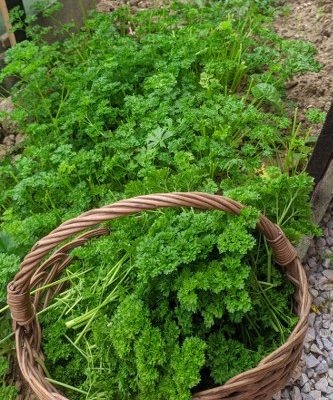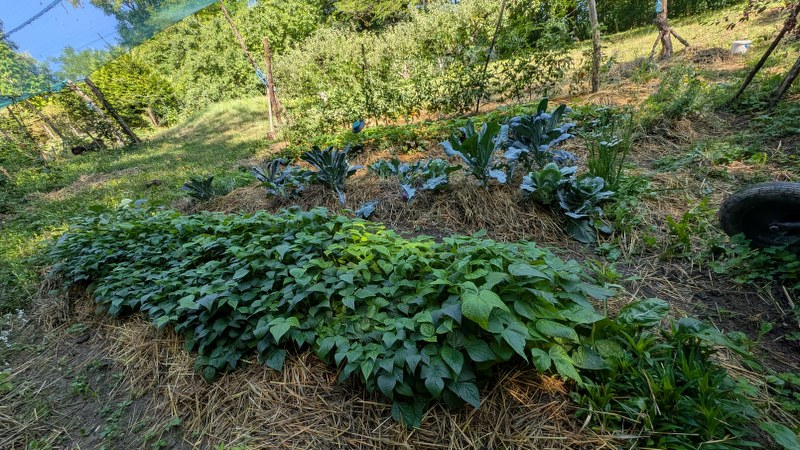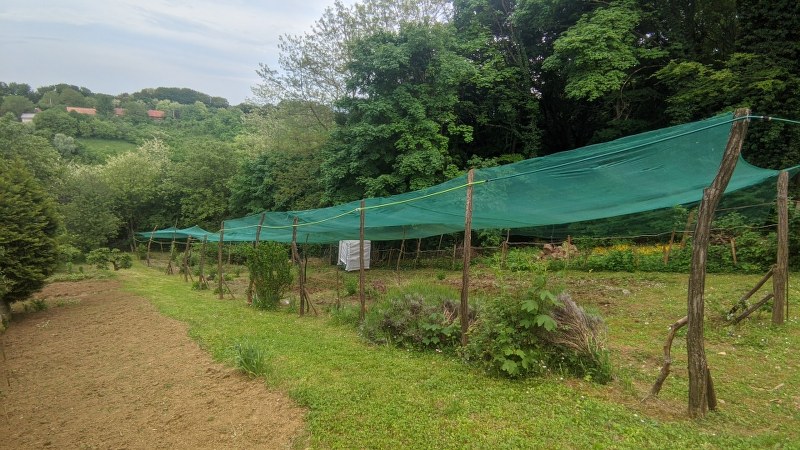Every herb garden needs parsley. Most of the meals are made with parsley. But what if regular parsley simply refuses to grow in our garden? Can curly parsley take its place? How can we grow, harvest and store it for next year?
What Is Curly Parsley Used For
Curly Parsley, a biennial plant, can be easier to grow, and more appealing to people who like the milder taste of parsley, making it a great addition to our herb and vegetable gardens. With its very decorative leaves, it is perfect as a fresh decoration on plates, chopped in soups and stews, as well as minced on meat and salads.
Another great thing about curly(and regular) parsley is that it can be easily dried and stored for winter. This is especially good in areas where harsh winters can freeze the plants or stop their production.

How To Sow Curly Parsley
Sowing curly parsley is very easy. It is sown the same way as regular parsley. But, since it doesn’t produce a big root it can be sown very dense and won’t use too much space. It is enough to sow the seeds in the soil around the end of March or April, when temperatures reach around 21°C(70°F), and water it regularly. Germination time is fairly long(14-28 days), but once it starts growing it will continue until a harsh frost kills it.
Curly parsley can also be sown in pots, and grown as a kitchen herb. Sowing can be done the same way as outdoor sowing. The germination will probably be faster than outdoors, due to the equal conditions throughout the days.
Curly parsley can also be started indoors and then transplanted outdoors. But, with the condition that the roots are not too damaged in the process. The best way is to directly transplant it with the soil in which it was growing.

Growing Curly Parsley
There’s not much care needed when it comes to parsley. What it does like is water. It will grow much quicker and nicer in cooler climates with regular watering. Once the leaves get big enough they need to be trimmed down to encourage the plant to form new leaves.

Our summer last year was very hot and extremely drought, and no matter how much water I gave it parsley just kept on standing still and didn’t grow. As soon as the weather changed and we started having rainy weather the plants started growing again.
The winter wasn’t too cold here, the lowest temperature was around -10°C(14°F), so my curly parsley didn’t freeze. Instead, as soon as we got temperatures around 10°C(50°F) it started growing, and with the extreme rain we’re having it is growing like mad.
Harvesting
As long as the parsley root is alive it can be harvested. Trimming the leaves will bring up new leaves and in a matter of weeks the plant will be ready for a new harvest. We can harvest them as needed or all at once and store them for a colder period.
I harvested my curly parsley a few days ago for the first time this year. Since this plant is biennial it can be harvested very early in spring. Even faster if it is in a covered or protected space. I’ve sown it in 3 different locations and the best-looking leaves are the ones that are growing in my semi-closed greenhouse.

Curly parsley is quite easy to harvest and in just a couple of minutes, I had a full basket of fresh leaves. Since I still have some leftover parsley and parsnip from last season I decided to store this parsley for next winter
How To Dry Curly Parsley
The easiest way to store parsley for winter is to dry it in the oven. Parsley dries very quickly, in just a couple of hours it will be completely moisture free. Parsley stored this way lasts for years.
I use only leaves when drying parsley. Although stems can also be dried, I find them very sharp and they never rehydrate. Instead, you have hard pieces of stems floating in the meals. This can be a problem with some meals. I could ground them into a powder after drying, but still, I prefer to remove them and use them fresh and save leaves for winter.
Once I harvest the parsley and remove the stems I wash them and after a quick drying, I just place them on the oven tray. I don’t bother removing the water completely from the washed leaves, the water will evaporate in the oven anyway. I have a fan oven so things dry faster.

Once the tray is full I set the oven to the lowest possible temperature(in my case that is 50°C/122°F), with both heaters and fan on. The oven door should be opened ajar. I use a wooden spatula which I stick between the oven and the door to leave a small air gap. My oven door closes on its own if it’s not open almost halfway.

As I said before, parsley will dry very fast. It will take a couple of hours to dry. I prefer to do my drying for 2 days. On the first day I dry them for 2 hours, leave them in the oven with opened door overnight, and in the morning I turn the oven to dry them for another hour and they are ready to be stored. This way the green herbs don’t lose their color.
Storing
Dried curly parsley is very crispy, so there is no need to ground it. It can be grounded between the fingers. In just a minute or two it will be ready for storing. Parsley can be stored in well-closed glass jars or vacuumed in small bags.

This year I’m using the vacuum-sealed method on all my herbs and dehydrated vegetables for one simple reason: bags take much less space than glass jars. I want to try and store as much food for winter as I possibly can, and with pickled food, jams, relishes, and drinks keeping my dehydrated vegetables in jars is taking up too much space. The sealed bags can be all stored in one big cardboard box, and the basement shelves will have much more space.

Parsley stored this way will be great for all of my winter meals and easily accessible. Once I empty the parsley kitchen jar I’ll just open one of the bags and fill the jar again. Since the vacuum bags which we got are quite thick. After emptying and washing them, I can reuse them again to store food again until they become too small. I’ll use the same method for all my dried herbs this year, including tea herbs and edible flowers.
Curly parsley is a great dried winter herb since the leaves are quite big. Just a couple of plants give a monthly amount of grounded parsley, so a yearly amount can be collected quickly.





Leave a Reply